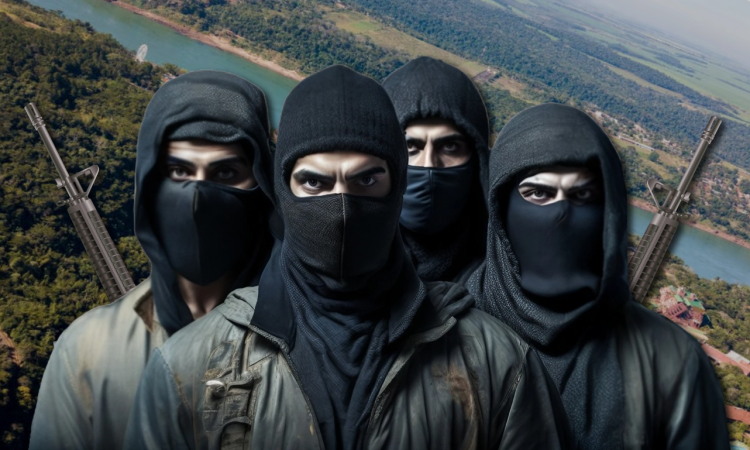Key Findings:
- Paraguay’s Ciudad del Este, Argentina’s Iguazú Port, and Brazil’s Foz do Iguaçu make up the tri-border area (TBA), a well known home for terrorist groups, drug cartels, and multiple illegal markets. The latter includes drug, weapon, and human trafficking, producing and selling counterfeit goods, and illicit tree logging.
- In the TBA, small drug cartels coexist with foreign criminal groups, such as Lebanon’s Hezbollah and Brazil’s First Capital Command, and politically and economically powerful clans whose control includes the Alto Paraná province judiciary in Paraguay.
- According to Israeli intelligence, Hezbollah is also in Venezuela, where it smuggles gold to Iran. That money finances Hezbollah’s terrorist attacks in the Middle East.
- While the main interest of foreign terrorist groups such as Hezbollah in Latin America is economic profits, their presence undermines institutions and law enforcement, making the region more vulnerable to other criminal groups’ attacks and occupation.
Overview
Ciudad del Este, located in the Paraguayan province of Alto Paraná, borders the Brazilian city Foz do Iguaçu and the Argentine city Iguazú Port. The point where the three countries meet is popularly known as the tri-border area (TBA) in South America. Home to at least six terrorist and armed groups, the TBA has busy illicit markets.
On June 15, 2023, news outlet Infobae revealed that three out of four Hezbollah members—those who allegedly perpetrated terrorist attacks in Argentina in the 1990s—are living in Ciudad del Este, Paraguay, and Foz do Iguaçu, Brazil.
This investigation explains why criminal groups are operating in the TBA, particularly in Ciudad del Este. For this purpose, the Impunity Observer interviewed Maria Zuppello—a journalist focused on crime and terror in Latin America—and César Niño—an international-relations professor at La Salle University in Bogotá, Colombia.
Known as the city of commerce, Ciudad del Este is the second most populated city in Paraguay, behind only the capital city of Asunción. Shopping and tourism from its Brazilian and Argentine neighbors is a common practice.
Emanuele Ottolenghi, senior fellow at the Foundation for Defense of Democracies, explains that the Alto Paraná province is a spot for the transportation of counterfeit goods. He contends that trade at this border has been lucrative to criminal groups “due to differentials in taxes and currency exchange rates.”
Due to illegal markets and lack of control by local authorities in Ciudad del Este, Niño argues the TBA is a “geopolitical black hole.” He explains the area has “zones where the state has no reach,” illegal border crossings, poor or nonexistent customs control, and corrupt public officials. These are the main reasons—apart from the arbitrage opportunities from currency exchange rates and differentials in taxes—for criminal groups to operate in the area.
Criminal Groups Operating in Ciudad del Este
Apart from hosting small narcotrafficking gangs, Ciudad del Este and the TBA are also home to national and transnational criminal groups:

First Capital Command: Created in 1993 in Sao Paulo, Brazil, the First Capital Command is involved in regional narcotrafficking and has over 30,000 members across South America. As a source of income, the First Capital Command has a stake in cigarette smuggling from Paraguay to Argentina and Brazil.
According to a report by the Brazilian news outlet O Globo, Hezbollah allegedly asked First Capital Command members to protect Lebanese prisoners in Brazil, where the Brazilians have power. In exchange, Hezbollah integrated the First Capital Command into the weapon smuggling business in Ciudad del Este.
Red Command: Created in the early 1970s as a leftist-militia organization in Brazil, Red Command is present in Brazil, Colombia, Paraguay, and Peru. The Red Command and the First Capital Command had an alliance to smuggle drugs from the Amazon region of Colombia and Peru. However, both actors broke their agreement in 2016, which has led to ongoing armed conflicts over control of that route. The Red Command, apart from smuggling marijuana and cocaine, is also involved in cigarette smuggling on the TBA.
Barakat Clan: Headquartered in Ciudad del Este, this criminal organization generates revenues from narcotrafficking, extortion, counterfeit money, and weapon and human smuggling. Part of their income goes to Middle Eastern terrorist groups, specifically Hezbollah. In fact, Assad Barakat, head of the clan, has been sanctioned by the United States for financing the international terrorist organization Hezbollah since 2004.
Barakat’s brother was a high-ranking official in the cultural affairs department of the Shura Council. The council is Hezbollah’s top decision-making authority and is led by Hezbollah’s head Hassan Nasrallah. Below the Shura Council, in the organization’s structure, there are five other councils: Judicial, Political, Executive, Parliamentary, and Jihad. Every head of the six different councils is under US sanctions for terrorism.
Zacarías Clan: The clan is made up of the Zacarías family, especially Senator Javier Zacarías and his wife Sandra McLeod. The Paraguayan Prosecutor General’s Office has accused both of corruption while being in public-sector positions in Ciudad del Este. According to the Paraguayan Prosecutor’s Office, they used public money to finance their own political campaigns in 2015 and 2017. Both belong to the Colorado Party, which has been the dominant ruling party in Paraguay for around 70 years. According to an InSight Crime report, the Zacarías Clan has control over the Alto Paraná judiciary, with an even bigger influence in Ciudad del Este.
Rotela Clan: This is a Paraguayan criminal organization led by the Rotela family. The clan started in 2007, and its main activity is drug microtrafficking. With many members in Paraguayan prisons, the Rotela Clan is in constant confrontation with First Capital Command inside prisons. According to Paraguayan media reports, the Rotela Clan’s presence in Alto Paraná is mostly limited to the province’s prisons.
Hezbollah: The terrorist group created in Lebanon in 1982 is also present in Ciudad del Este and the rest of the TBA. Its presence in the TBA has been ongoing for the past three decades. In the TBA, Hezbollah and its allies traffic drugs, counterfeit goods, and weapons to Europe and neighboring Argentina and Brazil. US intelligence explains that Hezbollah uses the Iranian regime’s airline Mahan Air for some of its trips to Venezuela and Iran.
Further, the Israeli intelligence agency Mossad identified both Hezbollah and Iran as responsible for the terrorist attacks in 1992 and 1994 in Argentina. The latter, a bombing of Argentina’s Israeli Association (AMIA), is one of the most prominent cases of terrorism in South America, in which 85 people died and more than 300 were injured. US, Argentine, and Israeli independent intelligence reports revealed funding and perpetrators of both attacks came from the TBA.
Zuppello told the Impunity Observer that the strong presence of Lebanese migrants—mainly due to the First Lebanon War in 1982, the Lebanese Civil War in 1975, and other armed conflicts—is another reason why Hezbollah has grown within the TBA. However, the presence of terrorist and other criminal groups has evolved over time, and multiple groups from Brazil have gained a larger presence in the area. In certain cases, such as the one of the First Capital Command, Brazilian criminal groups cooperate with local and foreign organizations.
Hezbollah’s Presence in Latin America
The US government has identified the presence of armed and terrorist groups in the TBA since the beginning of the 21st century. A 2003 report by the Federal Research Division of the Library of Congress spotted “six Islamic fundamentalist groups operat[ing] in the TBA.” These groups included Al-Gama’a al-Islamiyya, Al-Jihad, al Qaeda, Hamas, Hezbollah, and al-Muqawamah.
On June 15, 2023, Argentine Federal Judge Daniel Rafecas ordered the capture of four Lebanese men allegedly responsible for the AMIA terrorist attack in Argentina in 1994. The Prosecutor General’s Office claims that they are coauthors of the 1994 attack. According to an Infobae report, the four men, who are members of Hezbollah, are Hussein Mounir Mouzannar, Alí Hussein Abdallah, Farouk Abdul Hay Omairi, and Abdallah Salman. The report asserts that the first three live in the TBA. Meanwhile, Salman lives in Lebanon.
On June 24, Paraguayan Judge Gustavo Amarilla signed a resolution to freeze the assets of the four Lebanese men. The resolution will last six months and it establishes that authorities will provide any information regarding the Lebanese men to Argentine authorities.
Despite previous local and foreign reports of the presence of multiple international terrorist groups in Paraguay and the TBA, Paraguayan authorities listed Hezbollah and Hamas as terrorist organizations in 2019 with the stated objective of tackling these groups.
Niño explains that there are scant concrete actions from governments to tackle the presence of these criminal groups because Argentina, Brazil, and Paraguay do not have a clear understanding of the problem. For him, cooperation between all the countries involved in Hezbollah’s operations is necessary to help reduce its presence in the region. For Niño, cooperation at present is nonexistent.
There is limited scant information on cooperation between the United States and these three countries. However, in 2022 Paraguayan authorities deported Kassem Mohamad Hijazi—who lived in Ciudad del Este—to the United States for financing Hezbollah and laundering money from illicit sources. Hijazi is still under the control of US officials.
Hezbollah and Iran are also present in other parts of the region, specifically in Venezuela. In February, Israeli intelligence revealed the Iranian regime smuggled gold from Venezuela. The report said the regime-sponsored Mahan Air—US sanctioned—transported dozens of kilograms of gold. The Iranian regime allegedly sells this gold and uses the money to fund Hezbollah’s terrorist attacks in the Middle East.
A 2011 statement by former Assistant Secretary of State for the Bureau of International Narcotics and Law Enforcement Affairs William Brownfield warned about Iran’s growing presence in Latin America. Brownfield specifically referred to meetings between dictators Mahmoud Ahmadinejad and Hugo Chávez from Iran and Venezuela, respectively, and Iran’s opening of six new embassies across the region from 2006 until 2011.
The presence of multiple criminal groups in Ciudad del Este and the rest of the TBA is due to a series of factors such as the lack of presence of law enforcement, different tax rates across relatively open borders between Argentina, Brazil, and Paraguay, corrupt public officials, and impotent border control. However, experts—such as Niño—agree that terrorist groups in the area are focused more on economic revenue than on terrorizing the society. In the end, the larger presence of these groups makes the region more vulnerable to attacks and dominance from both local and foreign criminal organizations.
 Join us in our mission to foster positive relations between the United States and Latin America through independent journalism.
Join us in our mission to foster positive relations between the United States and Latin America through independent journalism.
As we improve our quality and deepen our coverage, we wish to make the Impunity Observer financially sustainable and reader-oriented. In return, we ask that you show your support in the form of subscriptions.
Non-subscribers can read up to six articles per month. Subscribe here.



